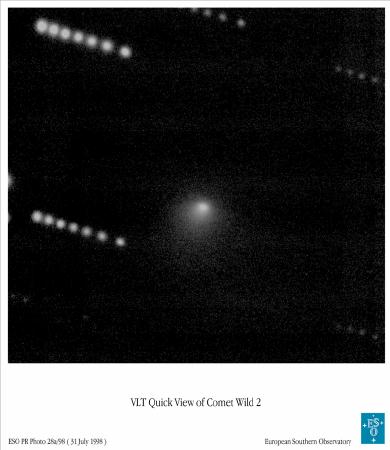


Some days ago, during short periods when no technical tests were scheduled, "quick shots" were obtained of comets.
The first comet image, Comet Wild 2, will be visited during NASA's STARDUST mission that will start early next year.
The VLT will be able to provide important support to both of these space missions by obtaining detailed observations of the comets and their momentary behaviour. In particular, the great light collecting power of the VLT Unit Telescopes will make it possible to study these comets exhaustively when they are farthest from the Sun in their orbits and hence very faint, shortly before the spacecraft encounters.
The first picture (ESO PR Photo 28a/98) is a composite of seven 2-minute exposures of Comet Wild 2, obtained through a red filter with the VLT Test Camera in the early morning of July 25, 1998. The observations were made during rather windy conditions, about 15 m/sec, whereby substantial, variable pressure was exerted on the upper part of the telescope structure. Still, the guiding worked very well and the resulting image shows the fine structure of the comet's "coma" of dust that has been released from the two-kilometre "dirty snowball" nucleus. In this combined image, the stars in the field are seen seven times each, reflecting the motion of the comet in the sky.
At the time of the observations, the comet was about 400 million kilometres from the Earth and 560 million kilometres from the Sun, moving outwards between the orbits of Mars and Jupiter. No reports of observations of Comet Wild 2 have been made since last year and the present image shows the comet in unprecedented detail at the current large distance. The angular size of the visible coma is about 20 arcseconds, or 40,000 kilometres (projected). The magnitude is 17-18, about 50,000 times fainter than what can be perceived with the unaided eye.
Comet Wild 2 moves around the Sun in an elliptical orbit with a period of 6.4 years. It was discovered by Swiss Astronomer Paul Wild in 1978. According to the current plan, the STARDUST spacecraft will encounter Comet Wild 2 in January 2004 and collect dust particles from the coma. At that time, the comet will be somewhat closer to the Sun and Earth than now. The STARDUST mission will bring the captured cometary dust particles back to Earth in January 2006. This will be the first time that a detailed laboratory analysis of such particles will become possible. It is assumed that this is original and widely unaltered material from the formation period of the Sun some 4.6 billion years ago.
Technical information for Photo 28a/98: Combination of seven 2-min R (red) exposures with the VLT Test Camera on July 25, 1998. The individual frames were flat-fielded, shifted in order to center the comet and then combined. The field shown measures 1.3 x 1.3 arcmin. North is up; East is to the left.
This is the caption to ESO PR Photo 28a/98. They are also available in high-resolution versions. They may be reproduced, if credit is given to the European Southern Observatory.
Ron Baalke, STARDUST Webmaster, ron@jpl.nasa.gov
Last Updated Wednesday, 07-Jun-2000 13:50:33 PDT